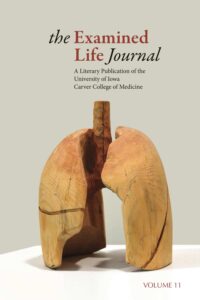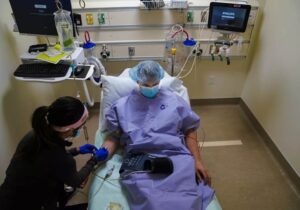Jim first encountered hospitalists during his stay for necrotizing (flesh-eating) pneumonia. Over the years, Jim’s experiences with hospitals have been many including cardiac by-pass surgery and a hip replacement. Both Jim and his wife Gwen, however, describe their recent experience with hospitalists as unsettling. When Jim was admitted into the hospital, his primary care physician could not help manage his care. The hospital had their own doctors.
What are Hospitalists?
- Physicians dedicated to hospitals will know hospital procedures. Such familiarity suggests greater efficiency and effectiveness when ordering tests, prescribing meds, and handling paperwork.
- Hospitalists know the clinical staff. Knowing clinical staff should facilitate coordination of different specialists, or forming a care team, depending on patients’ needs.
- A hospitalist provides a single point of contact (SPOC) for patients, families, and caretakers. A SPOC should improve communication and understanding of tests and procedures.
Jim's Experience
As a patient however, Jim is now dealing with a physician that doesn’t know him. A physician who doesn’t have experience with his medical history. Quite simply, the hospitalist doesn’t know what normal looks like. As Gwen put it, “the hospitalist doesn’t know that Jim’s face is very red all the time and that his face should be all red, maybe. And that when he came, if he was green, maybe your own doctor would know ‘Oh, he’s always green, he’s always blue.’”
Primary care physicians have both history with a patient and they know what is normal. Jim and Gwen experienced a lack of continuity in the delivery of care, during a dramatic health scare, a time when continuity matters.
So What are the Statistics on Hospitalists?
Recent studies have examined the role of hospitalists in both patient outcomes as well as in the transition of care when patients are discharged.
- In a study published in December 2017, the Journal of the American Medical Association concludes that “patients cared for during a hospitalization by their own primary care physicians had slightly longer lengths of stay, were more likely to be discharged to home, and were less likely to die within 30 days compared with those cared for by hospitalists.”³ These findings would suggest that familiarity does have an important role in patient outcomes.
- Another study, funded by Patient-Centered Outcomes Research Institute (PCORI) and published in the Annals of Family Medicine, examined care transitions from the perspective of patients and caregivers. The lead author on the study, Suzanne Mitchell, commenting on the findings during an interview with AAFP News said, “The real punchline is that despite millions, if not billions, of dollars of investment to improve care transitions in hospital discharges, from the patient and caregivers’ perspective, everything still looks the same.”⁴
Taking Charge of Your Hospital Experience
Hospital stays are often stressful; there is a lot happening that can be new and confusing. And the trend toward hospitalists is still on the upswing. As frustrating as it may feel, it is necessary for both patients and caretakers to take a more proactive approach regarding their care during a hospital stay and during discharge.
During the Hospital Stay
- Share all of your prescription medications as well as over the counter supplements with hospital personnel. Ensure that this information becomes part of your medical record in the hospital. Consider creating a list now. Keep it updated periodically and have it handy when needed. Such a list is important not just for a hospital stay but also for physician appointments outside of the hospital.
- Clarify whether or not the hospital utilizes hospitalists. If so, make sure to get to know this person. During a hospital stay, many hospital personnel rotate in and out of the hospital room. If a hospitalist should introduce him/herself, the introduction may get lost, or a term other than hospitalist is used. Make sure to know who the hospitalist is and ask this person to clarify his/her role, and share what to expect, going forward.
- Hospitalists work odd shifts – sometimes 7 days on and 7 days off. Find out the schedule so that you can be prepared if there is a change. Ask for a clarification of the hand-off procedure between hospitalists (does it happen in-person, through notes in the medical chart, e-mails, etc…)
- Confirm the hospitalist has been in touch with your primary care physician (if you have one) regarding your hospitalization and your diagnosis.
- Verify that other clinical personnel and specialists in the hospital are aware of the treatment plan and directions from the hospitalist. Ensure that everyone has the same understanding regarding medications and next steps.
Before/During Discharge
- Determine whether or not your hospitalist has consulted at any point with your primary care physician during your hospital stay. If so, identify what was communicated.
- Ensure there is a discharge plan for your release from the hospital. Make sure this plan is reviewed with you before you leave. Take the time to understand the discharge plan and ask any questions you may have regarding the plan. If there are concerns about safety, or what to expect when you get home, be sure to share these as well.
- Review the medications that are prescribed for you as part of your discharge. If there is a change in the list from when you went into the hospital, make sure you know the reasons for the change.
- Check to see if you have been provided with a number to call should you have any questions or concerns after you are discharged. If a number was not provided, ask for a number. Also ask for a number that is good 7 days a week, 24 hours a day, if you should need emergency assistance.
- Determine whether or not your primary care physician will be notified of your discharge. Ask when the primary care physician will receive the discharge summary from the hospital (typically it should arrive within two weeks, if not sooner.) Information to be included in a discharge summary: diagnoses, abnormal physical findings, important test results, discharge medications, follow-up arrangements made and appointments that still need to be made, counseling provided to the patient and family, and tests still pending at discharge. Request a copy of the discharge summary be sent to you as well.
⁵
Why Does It Matter?
These are just a few steps to take during a hospital stay to ensure safety and optimize care. Again, the hospitalist does not know what normal looks like. It’s important to share, if like Jim, your face is normally red. Or perhaps for you, normal is green or maybe even blue. For more information on improving communication between physicians and patients, check out this post on what happens when doctors listen.
Despite over-medication and other communication issues, Jim survived his bout with necrotizing pneumonia. He attributes his good fortune to very proactive family members who monitored his care and treatment. If you, or someone you love, requires hospital care, remain vigilant and use the practical steps outlined above as a guide to better manage care and treatment.
* Quotes in this post are from interviews conducted for my book, Navigating Illness: The Patient Experience, a work in progress. Names were changed upon an individual’s request.
1 Pantilat, S., (2006). What is a Hospitalist? The Hospitalist. https://www.the-hospitalist.org/hospitalist/article/123072/what-hospitalist.
2 Siamak, N., (2017). What Is a Hospitalist? MedicineNet.com. http://www.medicinenet.com/script/main/art.asp?articlekey=93946
3 Stevens, J. P., Nyweide, D. J., Maresh, S., et al. (2017) Comparisons of Hospital Resource Use and Outcome Among Hospitalists, Primary Care Physicians, and Other Generalists. JAMA Intern Med, 177(12): 1781-1787. doi.10.1001/jamainternmed.2017.5824
4 Porter, S. (2018) Patients, Family Caregivers Talk Tough on Care Transition. Annals of Family Medicine Research. https://www.aafp.org/news/practice-professional-issues/20180628annalstransitions.html
5 Kripalani, S., Jackson, A. T., Schnipper, J. L., Coleman, E. A. (2007) Promoting Effective Transitions of Care at Hospital Discharge: A Review of Key Issues for Hospitalists. Society of Hospital Medicine. 2(5). doi.10.1002/jhm228



